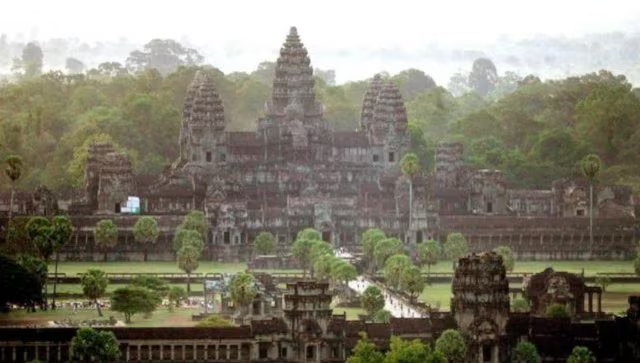Description

Disclaimer: Copyright infringement not intended.
Context
Angkor Wat temple in Cambodia becomes 8th wonder of the world, defeats Italy's Pompeii.
Details
Angkor Wat Temple
Location:
- Situated in the northern province of Siem Reap in Cambodia, Angkor Wat is the largest religious monument globally, covering approximately 1,200 square meters of intricately carved bas-reliefs.
Historical Significance:
- Construction: Built in the 12th century by Khmer Emperor Suryavarman II as a Hindu temple dedicated to Lord Vishnu, it was later converted into a Buddhist temple by Jayavarman VII.
- Transition to Buddhism: The transition from Hinduism to Buddhism is reflected in the temple's carvings, depicting scenes from both Hindu and Buddhist mythology.
- Adjacent Structures: Angkor Wat is part of a more extensive complex that includes the Bayon Temple in Angkor Thom, featuring numerous sculptural decorations.
- Archaeological Importance: The site spans 400 square kilometers and encompasses remnants of various capitals of the Khmer Empire from the 9th to the 15th centuries, making it a significant archaeological site in Southeast Asia.
Key Features:
- Architecture: Angkor Wat's architectural brilliance is showcased in its sandstone block construction and a 15-foot-high wall surrounding the city, temple, and residents, along with a wide moat for protection.
- Bas-Reliefs: Scores of bas-reliefs adorn the temple walls, depicting deities and narratives from Hindu and Buddhist traditions.
- Symbolism: The central temple complex's symmetry and precision feature five lotus-shaped towers representing Mount Meru, a mythical abode of gods in Hindu and Buddhist cosmology.

Interesting Facts:
- Alternate Names: Angkor Wat is also known as Yasodharapura and derives its name from the Khmer word "nokor," meaning "kingdom," originating from the Sanskrit word "nagara," meaning "city."
- UNESCO Protection: Recognizing its significance, UNESCO has a comprehensive program in place to protect Angkor Wat and its surroundings.
- Sunrise Spectacle: Tourists flock to witness the breathtaking sunrise over Angkor Wat's towers, which bathes the temple in stunning shades of pink, orange, and gold.
Pompeii
- It is an ancient city located near Naples in Italy, known worldwide for its remarkably preserved ruins following the catastrophic eruption of Mount Vesuvius in 79 AD.
Location:
- Pompeii was an ancient Roman city situated near the Bay of Naples in the Campania region of Italy, close to modern-day Naples.
History:
- Foundation: Founded around the 6th century BC by the Oscans, Pompeii was later influenced by Greek and Etruscan cultures before becoming a Roman colony around the 1st century BC.
- Eruption of Mount Vesuvius: In 79 AD, Mount Vesuvius, a nearby volcano, erupted catastrophically, burying the city under a thick layer of ash and pumice, freezing Pompeii in time.
Key Features:
- Archaeological Site: The ruins of Pompeii have been excavated over centuries, revealing streets, buildings, houses, public spaces, temples, and artifacts remarkably preserved by the volcanic ash.
- Architecture: The city's structures showcase Roman architecture of the time, including impressive villas, temples (like the Temple of Apollo), theaters (such as the Large Theater and the Odeon), and the famous amphitheater (the oldest surviving Roman amphitheater).
- Frescoes and Artifacts: Pompeii is renowned for its exquisite frescoes, mosaics, and artifacts that offer insights into daily life, culture, and artistry of the ancient Romans.
Cultural Significance:
- Historical Insights: The preservation of Pompeii provides invaluable information about ancient Roman life, architecture, art, and urban planning, offering a snapshot of life in the 1st century AD.
- Tourism and Education: Pompeii is a UNESCO World Heritage Site and a major tourist destination, attracting millions of visitors annually. It serves as an educational resource for archaeologists, historians, and tourists interested in ancient history.
.jpg)
Conclusion
Angkor Wat's architectural magnificence, cultural transition, rich historical significance, and UNESCO's preservation efforts collectively contribute to its status as a wonder and a compelling destination for millions of visitors annually.
MUST READ ARTICLE:
https://www.iasgyan.in/daily-current-affairs/7-wonders-of-the-world#:~:text=The%20actual%20wonders%20included%20are,the%20Taj%20Mahal%20in%20India.
|
PRACTICE QUESTION
Q. Which of the following statements correctly describes one of the Seven Wonders of the World?
Statements:
1. It is an ancient wonder that was dedicated to the Greek goddess Athena.
2. This wonder was destroyed by fire in the 3rd century AD.
3. Its construction began around 447 BC and completed in 438 BC.
Options:
A. Hanging Gardens of Babylon
B. Statue of Zeus at Olympia
C. Temple of Artemis at Ephesus
D. Mausoleum at Halicarnassus
Answer: C
|















